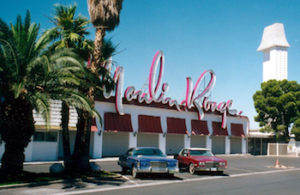
The Moulin Rouge
On this date in 1955, the first racially integrated American casino, the Moulin Rouge, opened in Las Vegas.
Built by three white-American men, Louis Rubin, Alf Childs, and Alexander Bisno, partners in a construction company, it became the “Apollo of the West Side.” At the end of World War II, President Harry Truman signed an executive order integrating the armed forces. Yet, segregated schools, municipalities, lodging, and entertainment venues were still an accepted way of American life.
Even with Jackie Robinson’s achievements in baseball, Black people were kept from moving up the social, civil, and economic ladder, especially in the South. Las Vegas held fast to the segregated views of the South because many southern whites not only spent money there but also held legislative power. The most prominent Black entertainers of the time, such as Bill Bojangles Robinson, Lena Horne, Sammy Davis, Jr., Louis Armstrong, and others, were welcomed on stage but expected to sit in the backseats of the very showrooms they headlined once their performances were finished. In the 1950s, the West side of Las Vegas had developed a sizable Black population, and 11 new hotels were built that decade.
African Americans were self-sufficient, and the Moulin Rouge was their answer. The stars that came to the hotel were fantastic, and the atmosphere was exciting. One could look into the audience, and everybody who was anybody, especially in Hollywood, was there. This was primarily for the third show at 2:30 a.m. In those years, Black entertainers working on the Strip could not socialize in the hotels where they worked, so they all came to the Moulin Rouge for the late show and met until 7 or 8 a.m.
The hotel had state-of-the-art equipment, some of the greatest food in town, and staff flew in from all over the country for the best service. “You could pull out a cigarette and be talking and talking and talking, and you’d look at the cigarette. It would be lit! It was too successful,” said William H. “Bob” Bailey, who was the Rouge’s MC, cast singer, and co-producer of its stage shows. As glamorous as it was, the Moulin Rouge was only open for six months. One night, when employees came to work, they found the doors covered with thick chains and padlocks.
No explanation was given, even to this day. Within a week of its closing, one of the Rouge’s partners became an executive at the Desert Inn, a notorious mob-run casino that had opened in 1950. Despite the theory that wealthy people of color would flock to the hotel, its doors may have closed due to a lack of just such support. Integration is a relationship of give and take. In the 1950s, many Vegas hotels consistently discouraged "colored" patronage, and being restricted to the Moulin Rouge did not appeal to America’s wealthier Blacks.
This entertainment was built for white control during the first half of the 20th century. Anytime a white club was in financial trouble, it would pull in a Black show to get them out of the red, and it worked. As long as they were doing well with white acts, they did not want to hire Blacks. They wanted Blacks only to make money for them. In the spring of 1960, with the persistence and savvy tactics of the NAACP, James McMillan, and Charles West, more political muscle, employment policies, and general civic and civil rights considerations in Las Vegas began to become a reality. These mandates forced the city to take off its Jim Crow white hoods.
In 1992, the hard work of a group called the Preservation of the Moulin Rouge resulted in the original building being placed on the National Register of Historic Places. The group was formed to restore the beauty of the Moulin Rouge and preserve its rich history and legacy.
The African American Desk Reference
Schomburg Center for Research in Black Culture
Copyright 1999 The Stonesong Press Inc. and
The New York Public Library, John Wiley & Sons, Inc. Pub.
ISBN 0-471-23924-0